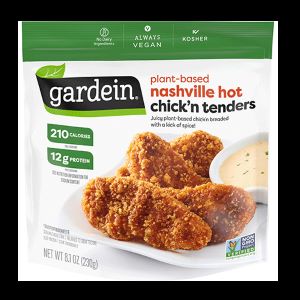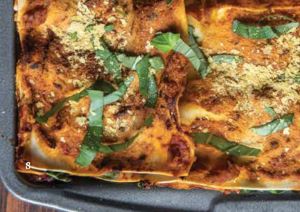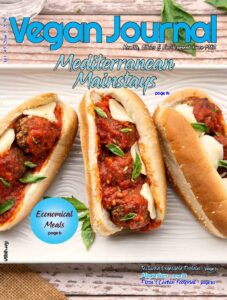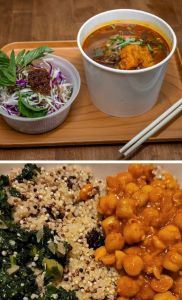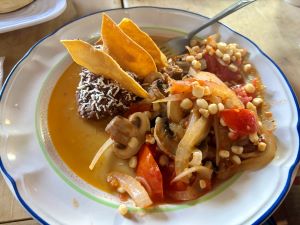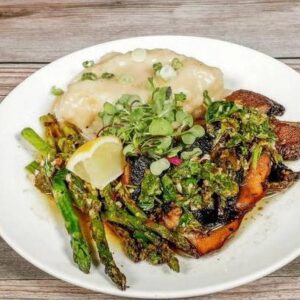Posted on
July 26, 2024 by
The VRG Blog Editor
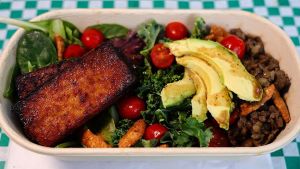
Photo from Vegan Galaxy Miami
The Vegetarian Resource Group maintains an online Guide to Vegan/Vegetarian Restaurants in the USA and Canada. Here are some recent vegan restaurant additions. The entire guide can be found here: www.vrg.org/restaurant
To support the updating of this online restaurant guide, please donate at: www.vrg.org/donate
Here are some new additions to VRG’s guide:
Hijo de Su Madre, 2180 Westwood Blvd., Unit 1G, Los Angeles, CA 90025
Located about a 10-minute drive from the UCLA campus in Westwood, California, Hijo de su Madre, which started off as a food truck before graduating to the current brick-and-mortar location, has made its mark in the competitive Los Angeles food scene. Inspired by the tastes and aromas of the owner’s family origins in the Yucatan (as indicated by its name), Hijo de su Madre is also very environmentally aware, using up-cycled furnishings in their space and recyclable wrappings, and even the aprons are made from 100% recycled materials. For those who dined at their food truck, some of those favorites have kept their place on the menu, including the Phat Hass Taco, made with a beer-battered and deep-fried Hass avocado, fresh pico, and a house spicy chipotle cream. The taco selection also includes No Stas Cochinita (tangy, sweet Yucatecan-style jackfruit, off-the-cob corn, and homemade black beans). Tacos are served on organic yellow corn tortillas, and if you’re especially hungry you can turn the tacos into a burrito or bowl—which have 3 times the taco portion. For those seeking traditional Yucatecan fare, there are options like the Kibis (lightly fried croquettes served with a side of black bean purée, guacamole, and pickled onions) and the Papadzules (rolled corn tortillas dipped in a sauce of pepitas and epazote, filled with a house made “hard-boiled egg” and topped with chiltomate sauce). The dessert menu is likewise an homage to family recipes, including the Pastelitos—empanadas filled with sweet potatoes and coconut, garnished with powdered sugar.
Moody Mike’s, 802 N. Limestone, Lexington, KY 40505
A vegan soul food truck with a variety of options including vegan chicken and fish sandwiches, lattes, and desserts.
Next Stop Vegan, 88 Livingston St., Brooklyn, NY 11201
Next Stop Vegan has burgers, burritos, salads, and several Latin dishes on their menu. Sandwiches and burgers include the sweet and spicy oyster mushroom sandwich with homemade chipotle sauce and sweet plantains as well as Cesar’s Philly Cheesesteak made with portobello mushrooms, peppers, onions, and vegan cheeses. The twisted burrito is loaded with seasoned and grilled portobello mushrooms, homemade mac n cheese, vegan beef, and fresh pico de gallo. Other Latin-inspired flavors include crispy mofonguitos (plantain-shredded baskets stuffed with quinoa meat, pico de gallo, and homemade cilantro and chimi sauce), plantakos (soft green plantain tacos), and loaded fries with vegan sausages, jalapeños, pico de gallo, and drizzled with homemade cilantro sauce, mayo, chimi sauce, and tangy BBQ sauce.
Odd Burger, 1050 Bank St., Ottawa, ON K1S 3X2 Canada
Odd Burger specializes in vegan fast food. This restaurant offers sides, “chickUN,” all day-breakfast, dessert, burgers, and more. All the ingredients used in specific dishes can be found on their website, where you can also place orders. Odd Burger also uses a variety of faux meats including house-made chickpea burgers, house-made sausage, gyro meat, and more! These are used in dishes like the “Vopper” burger and “Famous Style Fries”.
Ruby Baking Company, 811 E. Yellowjacket Ln. #122, Rockwall, TX 75087
A lighthearted, wholesome bakery with sweet treats for everyone. Desserts are all gluten-free, nut-free, and vegan. Some delicious options include cinnamon rolls, tiered cakes, and brownies.
Samata Vegan House, 1435 Highland Ave., Los Angeles, CA 90028
For Starters, there’s Mixed Tempura with pumpkin, broccoli, carrots, and more, Dumplings (choose steamed or fried,) Deep fried veggie Crispy Spring Roll with sweet and sour sauce, soy based Fries, Nuggets and all sorts of Wings. Salads include Cucumber Salad with Japanese ponzu sauce and sesame seeds, green Papaya Salad or Seasonal Fruit Salad—the last two with tomato, carrot, peanut, and chili lime dressing. In some cases, you may select your spice level. Stir-fried entrées include crispy fried, Orange Soy Chicken with homemade fresh orange sauce and sesame seeds, Broccoli Mushroom with stir-fried carrot and garlic, Spicy Eggplant or Ginger Delight—both with bell pepper, garlic, and other veggies to name a few. All come with “meat” – your choice of tofu, chicken, mixed veggies (or shrimp costs more). The last three come with homemade brown sauce. You might explore their virtual rainbow of Curry dishes—Red, Yellow, Green, or Panang. Most feature combinations of peas, bell pepper, green beans, and bamboo shoots. Soup choices include Coconut or Tom Yum – both with carrot, broccoli, cabbage, mushroom, and tomato in spicy and sour broths, the former with coconut milk. With oodles of Noodle dishes, you’ll have to use yours to narrow the choices! There’s Pad Thai, Udon, yakisoba, glass noodles, and many more. One of several Rice dishes is jasmine Pineapple Fried Rice with peas, carrot, onion, raisins, cashews, and curry powder. For a fruity kick, dessert choices are Coconut Ice Cream with Banana Roll or Mango with Sweet Coconut Rice.
Vegan Galaxy Miami, 90 NE 22nd St., Miami, FL 33137
Vegan Galaxy Miami is known for its good vibes. Some of their featured foods include Spinach Feta Borek, Folded Kimbap, and Baklava.
